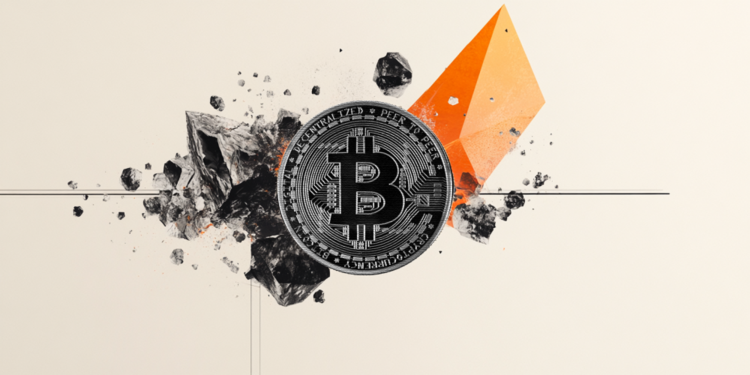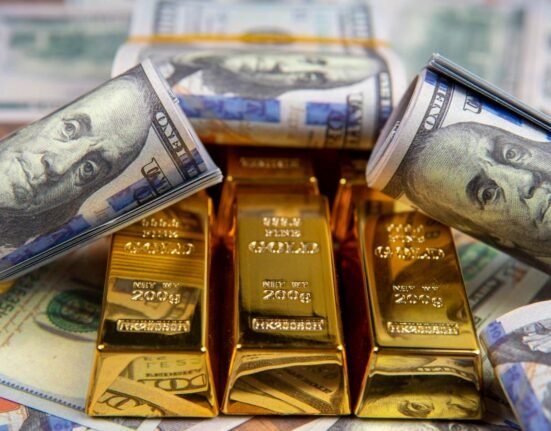- Gold gains nearly 20%, reaching a peak of $3,167, while Bitcoin nosedives nearly 12%, reaching a low of $76,606, in Q1 2025.
- In Q1, the World Gold ETF’s net inflows totalled 155 tonnes, while the Bitcoin spot ETF showed a net inflow of near $1 billion.
- FXStreet interviewed some crypto market experts regarding their views on Bitcoin and Gold in the current market condition.
Gold (XAU/USD) prices soared to record highs, gaining nearly 20% and reaching a peak of $3,167, while Bitcoin (BTC) prices nosedived nearly 12%, reaching a low of $76,606 in Q1 2025. In the first quarter, the World Gold Exchange Traded Funds (ETFs) recorded net inflows totalling 155 tonnes, while the Bitcoin spot ETF showed a net inflow of near $1 billion. To gain more insights on Gold and Bitcoin, FXStreet interviewed some experts in the crypto markets.
Gold’s stellar performance
Gold price skyrocketed during the first quarter, with its best quarterly increases in nearly 40 years. Gaining nearly 20% from January’s low of $2,614 to March’s high of $3,128, the yellow metal hit a new all-time high of $3,167 on Thursday.
US tariff concerns, geopolitical instability, expected Federal Reserve (Fed) interest rate cuts and strong central bank demand fueled this rally in the precious metal and positioned Gold as a safe-haven asset.
The State Street Global Advisors report highlighted Gold’s performance in Q1. The report explains that during the first quarter of 2025, World Gold ETF net inflows totalled a hefty 155 tonnes (t). This buying activity compares favourably to Q4 2024 net redemptions of 12t and Q1 2024 net outflows of over 106t.
“Recent growth in Gold ETF volumes, led by US investors and Western financial players for the first time since 2020, points to renewed macro interest in Gold portfolio allocations and macro tail hedges,” says the report.
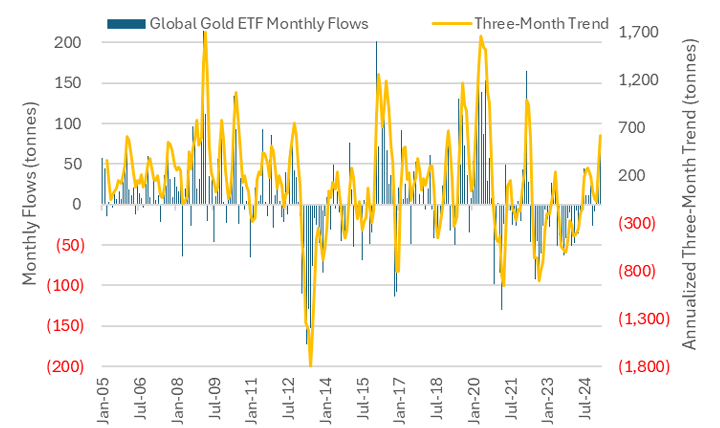
Global Gold ETF Inflow/Outflow Trend (net tonnes) Source: The State Street Global Advisors
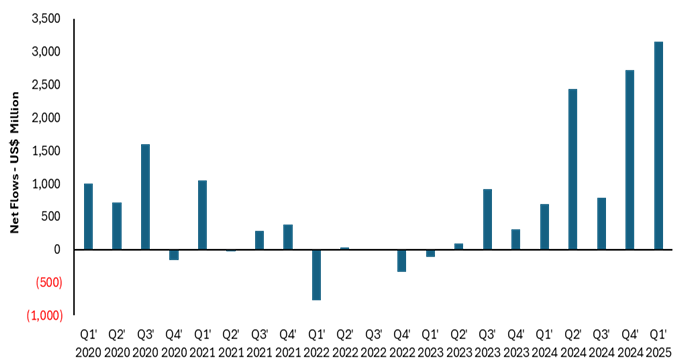
Net Inflows into APAC domiciled gold-backed ETFs chart. Source: The State Street Global Advisors
The report further explains that the rolling three-month trend of global gold ETF inflows in Q1 2025 was the strongest since April 2022 and the early weeks of the Russia–Ukraine conflict. Physically backed Gold ETF investors reversing a 3.5-year de-stocking cycle and starting to add to Gold holdings is a bullish development that can materially tighten supply/demand balances. In economic terms, transitioning from ETF selling to ETF buying is an aggregate demand shock for the Gold consumption curve.
“Notably, despite strong Q1 2025 inflows, total gold ETF tonnage is still down more than 20% from the all-time peak in October 2020. Under the proper market conditions, this implies plenty of scope for inflows to expand through 2025,” say the analysts.
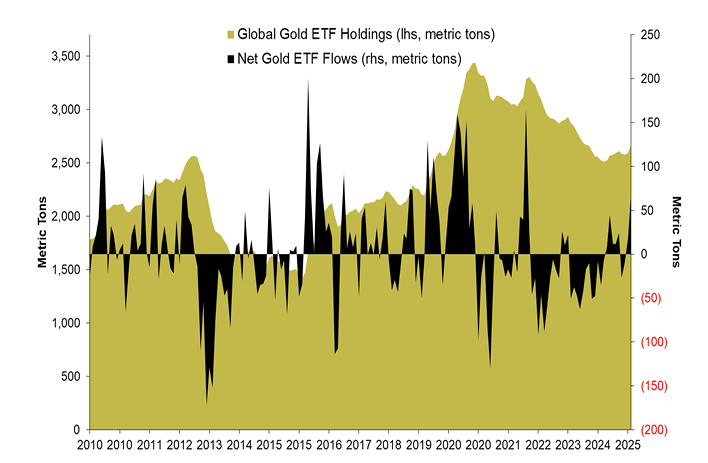
Global Gold ETF Holdings in metric tons chart. Source: The State Street Global Advisors
Bitcoin’s rough quarter
Bitcoin’s price nosedived and suffered its worst first-quarter performance since 2018, as shown in the graph below. BTC declined nearly 12% in the first quarter, reaching an all-time high of $109,588 in January and a low of $76,606 in March. At the time of writing on Friday, it trades at around $83,000. The drop can be attributed to macroeconomic uncertainty from US tariffs, a shift to safe-haven assets like Gold, and fading bullish momentum post-Trump’s election.
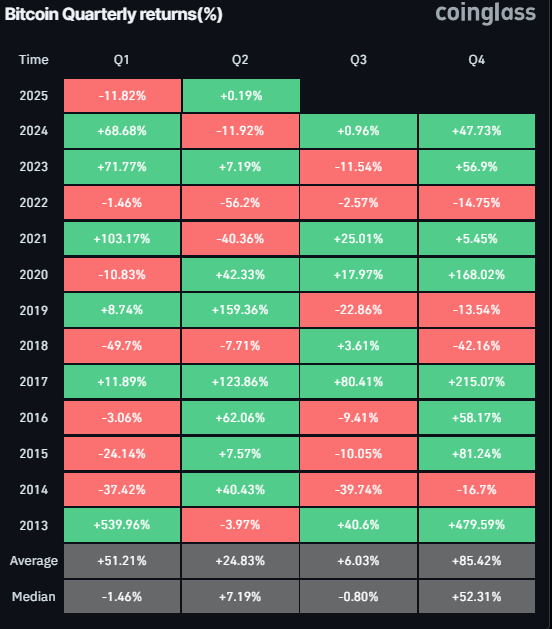
Bitcoin Quarterly return (%) chart. Source: Coinglass
Despite US President Donald Trump’s constant support for Bitcoin, as discussed in previous reports, establishing the Strategic Bitcoin Reserve and US Digital Asset Stockpile and attending the first-ever White House Crypto Summit (…), Bitcoin suffered its worst first-quarter performance since 2018.
Moreover, the rising interest of public firms in turning their balance sheets into Bitcoin vaults also failed to support its price last quarter. However, spot Bitcoin ETFs pulled in nearly $1 billion in the first quarter despite weak prices.
-638793536587049764.png)
Total Bitcoin Spot ETF chart. Source: SoSoValue
Why the divergence?
A K33 Research report this week highlights how Gold thrives while BTC tags along with any other risk asset. The report explains that Gold is a time-tested safe haven, while BTC is a young asset facing its first significant wave of institutional adoption.
“In our opinion, the Gold reflex from the market is fully rational, but it gives an informational edge for patient BTC accumulators,” says K33’s analyst.
The analyst continued, “Like Gold, BTC is scarce, with globally efficient pricing and strong liquidity. Unlike Gold, nation-state accumulation in BTC is in its very early days. Both assets are well-equipped to handle increased global friction gracefully, but BTC sits far earlier in its adoption cycle. Strategic Bitcoin reserves are a fresh new narrative, and formal processes and time will be needed to materialize and subdue the ongoing perception of BTC as a risk-on vehicle.”
Mike McGlone, Senior commodity strategist at Bloomberg Intelligence, posted on X that the Bitcoin-to-Gold ratio peaked around 2024, suggesting Bitcoin’s outperformance over Gold may have hit a ceiling. The recent decline indicates Gold’s resurgence.
In his X post, McGlone argues that Bitcoin behaves more like a leveraged asset than a “digital gold,” highlighting its volatility compared to Gold’s stability, which has been a safe-haven asset for centuries alongside silver, platinum, and palladium.
Moreover, the market sentiment for Gold’s appeal as a stable store of value versus Bitcoin’s riskier profile as a speculative asset. The rising investors’ risk-off stance amid tariff fears and economic uncertainty boosted Gold while pressuring Bitcoin. Forward-looking suggests that Gold’s upward momentum may persist if uncertainty lingers, while Bitcoin’s recovery hinges on policy clarity and its high correlation to the traditional markets.
Expert insights on Gold and Bitcoin
To gain more insight, FXStreet interviewed some experts in the crypto markets. Their answers are stated below:
Dan Greer, CEO and Co-Founder of Defi App
Q: What factors contributed to Bitcoin’s poor performance this quarter compared to Gold’s strong gains?
Bitcoin is still in its maturation phase, and it’s vulnerable to market volatility, especially when macroeconomic factors like interest rates are shifting. The Bitcoin price tends to be more reactive to sentiment, whereas Gold’s historical safe-haven appeal remains solid. The reality is, Bitcoin’s price volatility is part of its growth curve.
Q: Given Gold’s outperformance, is Bitcoin losing its appeal as a “digital gold” or inflation hedge?
Bitcoin’s narrative as ‘digital gold’ is evolving, and its current underperformance is more of a market cycle than a fundamental shift. Its appeal lies in its decentralized nature, offering a truly permissionless, borderless asset for those seeking an alternative to traditional financial systems. As Bitcoin infrastructure matures and adoption expands, its role as a hedge against inflation will continue to grow. There’s still a long-term bullish case for Bitcoin that’s more compelling as institutional adoption accelerates.
Q: What technical or on-chain indicators should we look at to understand Bitcoin’s underperformance this quarter?
The hash rate and wallet growth are key indicators to watch. Despite price fluctuations, Bitcoin’s fundamentals remain robust. A growing hash rate indicates rising confidence in its long-term viability, while wallet growth is an essential indicator of adoption. Our platform, Defi App, is seeing growing interest in tools that allow users to track these metrics and better understand market trends.
Q: Looking ahead, do you expect Bitcoin to recover from this slump, or could Gold continue to dominate as a value store?
Bitcoin will recover, no question. It’s part of the natural ebb and flow of a maturing asset. Gold will always have a place as a store of value, but Bitcoin’s fixed supply and decentralized features make it increasingly attractive in the digital age. While Gold has its place, Bitcoin’s potential for long-term value storage will continue to strengthen as more institutional players come on board.
Ian Balina, CEO at Token Metrics
Q: How do macroeconomic conditions, like interest rates or inflation, influence the current divergence between Gold and Bitcoin?
Macroeconomic factors like interest rates and inflation are critical. Bitcoin, like Gold, is often seen as a hedge against inflation. But in today’s market, rising interest rates are creating headwinds for both. Some traditional investors are seeing Gold as a safer bet right now, while Bitcoin is still viewed by many as an emerging asset. Once we have regulatory clarity, Bitcoin could reclaim its rightful place as a hedge and store of value.
Q: Were specific events (e.g., ETF approvals, mining issues, or hacks) disproportionately impacted Bitcoin this quarter?
Yes, certain events had a big impact, like miners’ struggles with energy costs and operational efficiency. ETFs, while promising, didn’t have the same immediate effect some expected. But the bigger issue has been the ongoing market sentiment and fear of unclear regulations. Bitcoin is still facing a battle with institutional adoption, but once the technical hurdles and regulatory concerns clear up, you’ll see Bitcoin return to form.
Q: What role did regulatory developments or market sentiment play in Bitcoin’s struggles this quarter?
Regulatory uncertainty has played a huge role. When governments introduce new rules or enforcement actions, it makes investors nervous. The lack of clear regulation is a significant factor in Bitcoin’s underperformance this quarter. But once we see clearer, pro-crypto regulations coming from the Trump administration, we’ll see a strong market recovery. Market sentiment also matters, but regulation is the key hurdle right now.
Cory Klippsten, CEO at Swan Bitcoin
Q: Are investors shifting capital from cryptocurrencies to traditional safe-haven assets like Gold, and if so, why?
Yes, but let’s be clear: most of that capital was in garbage tokens and speculative nonsense that never deserved investment in the first place. When the music stops, people rush to the exits. Some go to Gold. The smart ones go to Bitcoin. If Bitcoin gets temporarily lumped in with crypto scams, that’s a miscategorization, not a reflection of its fundamentals.
Q: How do you see the correlation—or lack thereof—between Bitcoin and Gold evolving in the coming months?
Over the short term, correlation is driven by the same players rotating portfolios based on headlines. Over the long term, Bitcoin is on its own path. As trust in governments, central banks, and fiat currencies continues to deteriorate, Bitcoin will emerge as the only logical alternative. Gold is the analog solution. Bitcoin is the digital future.
Q: Does Gold’s recent success signal a broader trend of investors favouring tangible assets over speculative ones like Bitcoin?
That framing is wrong. Bitcoin is not speculative—it’s misunderstood. Dog coins and VC-backed crypto projects are speculative. Bitcoin is a monetary revolution. If investors are waking up to the failure of fiat and pivoting to hard assets, that’s great. Eventually, they’ll realize Gold is slow, centralized, and vulnerable. Bitcoin is the next evolution.
Q: Looking ahead, do you expect Bitcoin to recover from this slump, or could Gold continue to dominate as a value store?
Gold may dominate headlines in the short term, but it won’t dominate the future. Bitcoin is still in price discovery. Gold had 5,000 years to establish trust. Bitcoin’s done it in 15. Recovery isn’t even the right word—Bitcoin is simply repricing on a long timeline. The market will catch up to reality eventually. The smart money is already there.
Adam O’Brien, CEO at Bitcoin Well
Q: What factors contributed to Bitcoin’s poor performance this quarter compared to Gold’s strong gains?
Bitcoin is finding its place in the asset world. Comparing it to Gold is amazing and shocking as Gold is a safe haven asset – arguably the safest of havens. Traditional assets struggled this quarter as well and I think Bitcoin will continue its rise to dominance against Gold, but it will take time.
Q: How do macroeconomic conditions, like interest rates or inflation, influence the current divergence between Gold and Bitcoin?
People rush to “known safety” during times of uncertainty. Bitcoin is a “known safety” for a very small number of people, but it’s growing. If I had to hold Gold or Bitcoin over the next 50 years, I certainly wouldn’t choose the heavy shiny metal.
Q: Given Gold’s outperformance, is Bitcoin losing its appeal as a “digital gold” or inflation hedge?
Not at all. It’s cementing itself as the superior asset. All the money evacuated traditional assets (stocks/bonds) and most went into Gold, with only a little bit into Bitcoin. In future years, more will go into Bitcoin and less into Gold.
Crypto ETF FAQs
An Exchange-Traded Fund (ETF) is an investment vehicle or an index that tracks the price of an underlying asset. ETFs can not only track a single asset, but a group of assets and sectors. For example, a Bitcoin ETF tracks Bitcoin’s price. ETF is a tool used by investors to gain exposure to a certain asset.
Yes. The first Bitcoin futures ETF in the US was approved by the US Securities & Exchange Commission in October 2021. A total of seven Bitcoin futures ETFs have been approved, with more than 20 still waiting for the regulator’s permission. The SEC says that the cryptocurrency industry is new and subject to manipulation, which is why it has been delaying crypto-related futures ETFs for the last few years.
Yes. The SEC approved in January 2024 the listing and trading of several Bitcoin spot Exchange-Traded Funds, opening the door to institutional capital and mainstream investors to trade the main crypto currency. The decision was hailed by the industry as a game changer.
The main advantage of crypto ETFs is the possibility of gaining exposure to a cryptocurrency without ownership, reducing the risk and cost of holding the asset. Other pros are a lower learning curve and higher security for investors since ETFs take charge of securing the underlying asset holdings. As for the main drawbacks, the main one is that as an investor you can’t have direct ownership of the asset, or, as they say in crypto, “not your keys, not your coins.” Other disadvantages are higher costs associated with holding crypto since ETFs charge fees for active management. Finally, even though investing in ETFs reduces the risk of holding an asset, price swings in the underlying cryptocurrency are likely to be reflected in the investment vehicle too.

